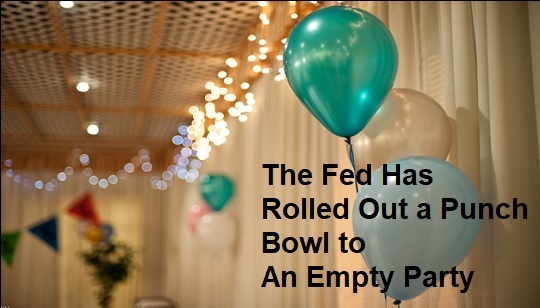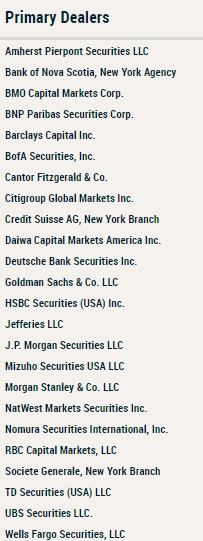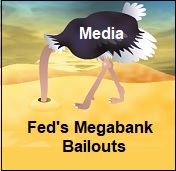-
Recent Posts
- Trump’s “Big Beautiful Bill” Is a Grotesque Giveaway to Fossil Fuel Billionaires While Adding $3.3 Trillion to Nation’s Debt
- Senator Chris Murphy Charges that Trump “Has Opened a Channel for Bribery”
- Congressman Casten: Trump’s Assault on the Rule of Law Is Causing Capital Flight Out of U.S. by Foreign Investors
- Trump’s Approval Rating Drops to 80-Year Low; IMF Says U.S. Tariffs Now Exceed the Highs During the Great Depression
- Nasdaq Has Lost More than 3,000 Points Since Trump’s First Full Day in Office in 2025; the Pain Has Barely Begun
- The Bond Crisis Last Week Was a Global No-Confidence Vote in U. S. President Donald Trump
- Trump’s Tariff Plan Guts $5 Trillion in Stock Value in Two Days; Senator Warren Calls for Emergency Action Before Markets Open on Monday
- Trump’s Attacks on Big Law, Universities, and the Media Have a Common Goal: Silence Dissent Against Authoritarian Rule
- Trump Administration Gives All Clear to Laundering Money through Shell Companies and Bribing Foreign Officials
- Four Megabanks on Wall Street Hold $3.2 Trillion in Uninsured Deposits – Which May Explain Senator Schumer’s Pivot to the GOP to Stop a Government Shutdown
- Here’s What Came Crashing Down Yesterday for Trump’s “Genius” Guy, Elon Musk: Tesla Stock, Access to Twitter (X), His Years of Secret Calls with Putin
- After Banning the Associated Press, Trump Is Now Targeting Specific Journalists That He Wants to See Fired
- Closely Watched Atlanta Fed Model Predicts Negative U.S. Growth in First Quarter
- Trump’s Gangster Diplomacy Makes Front Page Headlines Around the Globe
- Who Benefits Alongside Elon Musk If He Succeeds in Killing the CFPB: the Megabanks on Wall Street that Underwrite His Tesla Stock Offerings
- In Trump 1.0, the State Department Used Taxpayer Money to Publish a Book Elevating Elon Musk to a Superhero; It Was Funded by USAID, the Agency Musk Wants to Quickly Shut Down
- News Host Joy Reid Raises Threat of Trump Selling U.S. to Putin; Ten Days Later Her Show Is Cancelled
- Elon Musk’s DOGE Appears to Be Violating a Court Order; It Has Taken Down Hundreds of YouTube Videos that Educate Americans on How to Avoid Being Swindled
- Barron’s Releases Audio of Jamie Dimon Cursing Out His Workers at a Town Hall, as Dimon Plans to Dump Another One Million JPM Shares
- There’s One Federal Investigative Agency that Neither Trump nor Elon Musk Can Touch: It Just Opened an Investigation into DOGE
- Elon Musk’s Companies Were Under Investigation by Five Inspectors General When the Trump Administration Fired Them and Made Musk the Investigator
- Donald Trump Gives the Greenlight to Goldman Sachs and JPMorgan Chase to Return to Bribing Foreign Officials
- After Tech Geeks Built a Back Door to Loot Billions from FTX, Republicans Refuse to Investigate What Elon Musk’s Tech-Squad Did Inside the U.S. Treasury’s Payment System
- Former Prosecutor, Now U.S. Senator, Informs Tesla That CEO Musk May Be Violating Federal Law and to “Preserve All Records”
- Trump’s Hedge Fund Guy Is Now Overseeing the U.S. Treasury, IRS, OCC, U.S. Mint, FinCEN, F-SOC, and the Consumer Financial Protection Bureau
- As Elon Musk Begins Shutting Down Payments to Federal Contractors, a Strange Money Trail Emerges to His Operatives Inside the U.S. Treasury’s Payment System
- JPMorgan Chase Charged by Yet Another Internal Whistleblower with Cooking the Books
- We Asked Google’s AI Search Model, Gemini, Questions About the Fed and Wall Street Megabanks: It Got the Answers Dead Wrong
- With Trump and Melania’s Crypto Coins Likely to Raise Legal Challenges, Why Didn’t Trump Fire the SEC’s Inspector General in His Purge of IGs?
- Fossil Fuel Industry Could End Up Paying Tens of Billions for LA Wildfires and Deceiving the Public on Climate Change for Decades
- It’s Being Called the Biggest Grift by a President in U.S. History: Trump and First Lady Launch their Own Crypto Coins
- Trump Plans to Install a Fracking CEO to Head the Energy Department and Declare a National Emergency on Energy to Gain Vast Powers
- Fossil Fuel Money Played a Role in the Los Angeles Fires and the Push to Install Pete Hegseth as Secretary of Defense
- When It Comes to Wealth Retention in Retirement, Concrete May Be the New Gold
- Wall Street Watchdog Warns “Clock Is Ticking on a Coming Catastrophic Financial Crash”
- Wall Street Is Sending the Same Message to Americans on Fossil Fuel Financing that It Sent on Cigarettes: Drop Dead
- In a Six-Week Span, this Dark Pool with a Curious Past Traded 3.7 Billion Shares
- Wall Street’s Lobby Firm Hired Eugene Scalia of Gibson Dunn to Sue the Fed for Jamie Dimon
- Postmaster General Louis DeJoy Made $561,051 in Compensation in 2024, as Mail Costs Spiked and Delivery Deteriorated
- Fed Chair Jay Powell Sends a Bold Message to Trump and Tanks the Dow by 1123 Points
- The Head of Fixed Income at T. Rowe Price Makes the Scary Case for the 10-Year Treasury to Spike to 6 Percent
- $663 Billion in Cash Assets Have Gone Poof at the Largest U.S. Banks
- Donald Trump to Ring Bell at New York Stock Exchange Today as Hit List Posters Appear in Manhattan Targeting Wall Street CEOs
- Trump Has a Slush Fund to Prop Up the Dollar – Will He Use It to Prop Up Bitcoin Instead?
- A CEO Assassination; a Billionaire Heiress/NYPD Commissioner; a Secret Wall Street Spy Center – Here’s How They’re Connected
- Despite More than 1600 Tech Scientists Signing a Letter Calling Crypto a Sham, Trump Names a Crypto Cheerleader for SEC Chair
- The Fed Rings a Warning Bell: Hedge Funds and Life Insurers Are Reporting Historic Leverage
- Trump’s Nominee for FBI Director, Kash Patel, Has Businesses Financially Intertwined with Trump
- Donald Trump Is at Risk of Getting Named in a Fossil Fuels Conspiracy Lawsuit
- Trump Is Having Difficulty Getting a Lawyer to Accept the Nomination for SEC Chair: Here’s Why
Search Results for: Federal Reserve
Fed’s Balance Sheet Skyrockets to $4.7 Trillion

By Pam Martens and Russ Martens: March 19, 2020 ~ The Fed’s H.4.1 report was released at 4:30 p.m. today and it shows that the Federal Reserve’s balance sheet has skyrocketed to $4.7 trillion. It also shows that as of yesterday, its repo loans to the trading houses on Wall Street had soared to a total of $441.9 billion outstanding while borrowings from its Discount Window added another $28.2 billion, bringing the combined total to over $470 billion in loans outstanding. Wall Street has been receiving hundreds of billions of dollars a week in assistance from the Fed since September 17, 2019 while struggling Americans have yet to see a dime of assistance to help offset job losses from the coronavirus outbreak. The Fed doesn’t have to wait for a vote in Congress to funnel $9 trillion in cumulative loans to Wall Street. It can create an unlimited amount of … Continue reading
Wall Street’s Crisis Began Four Months Before the First Reported Death from Coronavirus in China; Here’s the Proof
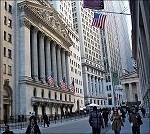
By Pam Martens and Russ Martens: March 19, 2020 ~ U.S. Treasury Secretary Steve Mnuchin and Wall Street pundits are all over cable news, repeating the mantra that “this is nothing like the last financial crisis,” while seeking to lay the blame for all of the newly-announced bailout measures for Wall Street at the feet of the coronavirus. But in terms of Wall Street privatizing profits and socializing losses, this is exactly like the last financial crisis. Wall Street’s crisis has a specific launch date: September 17, 2019. That’s when the Fed, for the first time since the last financial crisis, began dumping hundreds of billions of dollars a week into Wall Street’s trading houses. That program, called “repo loans,” now tallies up to more than $9 trillion in cumulative loans made to Wall Street at super-cheap borrowing rates. The first article we wrote on that Fed program was dated … Continue reading
Fed Announces Program for Wall Street Banks to Pledge Plunging Stocks to Get Trillions in Loans at ¼ Percent Interest
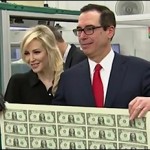
By Pam Martens and Russ Martens: March 18, 2020 ~ The Federal Reserve Board of Governors announced at 6 P.M. last evening that it is following the direction of Steve Mnuchin, the former foreclosure king who now serves as U.S. Treasury Secretary, and authorizing the reinstatement of a hideously operated, multi-trillion dollar bailout program for Wall Street’s trading houses known as the Primary Dealer Credit Facility (PDCF). Veterans on Wall Street think of it as the cash-for-trash facility, where Wall Street’s toxic waste from a decade of irresponsible trading and lending, will be purged from the balance sheets of the Wall Street firms and handed over to the balance sheet of the Federal Reserve – just as it was during the last financial crisis on Wall Street. The Fed fought for years in court to keep the details of the PDCF and its sibling Wall Street bailout programs a secret … Continue reading
Here’s Why the Fed Hasn’t Yet Invoked Its 13(3) Emergency Powers to Stem a Stock Market Crash
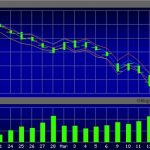
By Pam Martens and Russ Martens: March 17, 2020 ~ The U.S. stock market set new records yesterday – all of them bad. The Dow Jones Industrial Average suffered its worst point loss in history, closing down 2,997 points at 20,188.52, which effectively erases all of its gains in the last three years. On January 20, 2017, when Donald Trump was sworn in as President, the Dow closed at 19,827. It’s now grown by just 1.8 percent in total over that span of time. The Dow also had its second worst percentage loss in history yesterday, losing 12.93 percent. That loss is only exceeded by Black Monday, October 19, 1987, when the Dow lost 22.6 percent. It barely beats out October 28, 1929 when the Dow lost 12.8 percent and ushered in what would become the worst stock market crash in history. From late 1929 to 1933 the stock market … Continue reading
The Fed Tried to Give Away $1 Trillion to Wall Street Today and Failed, Suggesting Specific Banks Are In Trouble
By Pam Martens and Russ Martens: March 16, 2020 ~
What is the world coming to when the New York Fed can’t mix up $1 trillion of almost-free money in its punch bowl and get the mega Wall Street banks to drink freely?
The New York Fed handed out $129.60 billion this morning at an average interest rate of 0.112. That was for a one-day loan to one or more of Wall Street’s trading firms. The specific names of which firms are doing the borrowing are a closely-guarded secret at the Fed – just as they were during the financial crisis in 2008 until media lawsuits and a legislative amendment forced the banks’ names out into the open. All that the public is allowed to know today is that any of the Fed’s 24 primary dealers (Wall Street trading houses) are allowed to borrow from the facility. (See list below.)
The New York Fed also offered $500 billion in a 28-day loan this morning and, stunningly, it only had offers for $18.45 billion of the $500 billion, which was loaned at an average interest rate of 0.151 percent.
Despite that poor showing at its money spigot party this morning, the New York Fed made a surprise announcement and said it was throwing another money giveaway of $500 billion at 1:30 p.m. today. Again, only takers for $19.40 billion of the $500 billion showed up. The loans were made at the incredibly low average interest rate of 0.102 percent.
There was this same lack of demand last Thursday and Friday when the Fed tried to give away, almost for free, $1.5 trillion over the two-day span.
What could possibly account for this lack of greed from the typical pigs at the trough?
The reason that jumps to mind to anyone who has been following the Fed’s money spigot closely, is that there are only a handful of Wall Street banks that are in desperate need of this cash. Since the beginning of this program last fall, the New York Fed has imposed caps on how much any one of the 24 Wall Street firms could borrow at each offering. It refers to this limit as a “proposition.”
So, for example, on the latest $500 billion loans, firms can make a “proposition” up to $20 billion on loans backed by U.S. Treasury collateral and up to $20 billion on loans backed by government-backed mortgage securities. It’s not clear if the Fed would provide an individual bank with a total of $40 billion on that specific loan or just $20 billion for both propositions.
It’s also not clear if the Fed has, without the public’s knowledge, imposed an overall cap on how much any one bank can borrow within a specific period of time.
But what today’s unscheduled afternoon loan operation suggests is that a bank that borrowed last Thursday or Friday or this morning, may have been in need of more assistance this afternoon.
We looked at how the Fed’s primary dealers were trading today to see which banks were showing the most distress. At approximately 2:30 today, these banks were showing large percentage declines on the day: Citigroup was down a scary 18.24 percent; Morgan Stanley was down 14.35 percent; Bank of America was down 14.38 percent; and JPMorgan Chase was down 13.64 percent.
Deutsche Bank had earlier in the day traded at a new all-time low of $4.99 before bouncing back to $5.39 for a percentage decline of 9.67 percent. That leaves the bank with just $11.5 billion in common equity capital versus tens of trillions of dollars (notional) in derivatives exposure.
The Fed Has Pumped $9 Trillion into Wall Street Over the Past Six Months, But Mnuchin Says “This Isn’t Like the Financial Crisis”
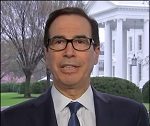
By Pam Martens and Russ Martens: March 14, 2020 ~ On February 12, 2020, the Dow Jones Industrial Average closed at 29,551.42. Yesterday, March 13, the Dow closed at 23,185.62 -– a loss of 6,365.80 points in one month’s time, or 21.54 percent. In 2008, the greatest financial calamity since the Great Depression, the Dow had lost 2,339.60 points or 21.4 percent one month after the frightening events of September 15, 2008 when Lehman Brothers filed bankruptcy, Merrill Lynch had to be taken over by Bank of America, and one day before the U.S. government seized the giant insurer, AIG, because it couldn’t pay the tens of billions of dollars in derivative bets it had made with the mega banks on Wall Street. On this past Friday morning, in what appeared to be an effort to restore confidence on Wall Street, U.S. Treasury Secretary Steve Mnuchin gave an interview on … Continue reading
The Fed Has 233 Secret Documents about JPMorgan’s Potential Role in the Repo Loan Crisis
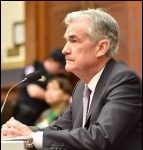
By Pam Martens and Russ Martens: March 13, 2020 ~ The Federal Reserve Board of Governors has acknowledged to Wall Street On Parade that it has 233 documents that might shed some light on why JPMorgan Chase was allowed by the Fed to draw down $158 billion of the reserves it held at the Fed last year, creating a liquidity crisis in the overnight loan market according to sources on Wall Street. After taking four months to respond to what should have been a 20-business day turnaround on our Freedom of Information Act request, the Federal Reserve denied our FOIA in its entirety. (Our earlier request to the New York Fed resulted in the same kind of stonewalling. See The New York Fed Is Keeping JPMorgan’s Secrets Close to Its Chest.) The Wall Street liquidity crisis forced the Federal Reserve, beginning on September 17 of last year, to begin making … Continue reading
Another Dangerous Virus Hits the U.S. – Wall Street Bank Contagion
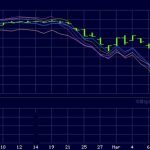
By Pam Martens and Russ Martens: March 12, 2020 ~ There has been a lot of delusional talk about the strong capital levels of the mega banks on Wall Street, not only from the Federal Reserve, but also from Wall Street analysts spreading fantasies about the banks on cable news programs. We took an afternoon off last Friday to hear what was being said about the banks on CNBC. We were stunned to hear Mike Mayo, a long-tenured bank analyst on Wall Street, who currently works for Wells Fargo Securities, deliver a huckster-like assessment of the mega Wall Street banks. Mayo said this: “The banking industry has the strongest balance sheet in a generation. Now think about this: the banks have added $1 trillion of additional capital – that’s $1 trillion with a T; $2 trillion of additional cash; $3 trillion of additional deposits. You have a Federal Reserve stress … Continue reading
There Was a Bloodbath in Wall Street Banks and Insurers Yesterday

By Pam Martens and Russ Martens: March 10, 2020 ~ President Donald Trump is bringing a pea shooter to a gunfight. If you look carefully at the charts on this page from yesterday’s trading bloodbath, it’s clear that there is a deep financial crisis playing out. The idea that this can be remedied with a payroll tax cut is the stuff of tooth fairies. And this crisis didn’t begin with the coronavirus. Headlines about the virus did not start appearing in the U.S. until January of this year. But the Federal Reserve began making hundreds of billions of dollars each week in cheap loans to Wall Street’s banks on September 17, 2019 — the first time it had done this since the 2008 financial crisis. You can earmark September 17, 2019 as the actual date that this Financial Crisis II got underway. All of the toothless financial reforms of the … Continue reading
What’s the End Game in the Saudi Oil Price War?

By Pam Martens: March 9, 2020 ~ In early afternoon trading, West Texas Intermediate, the domestic crude oil in the U.S., had lost over 20 percent on the day, 39 percent in the last 18 calendar days and 48 percent from its peak this year. The panic selling resulted from a failed OPEC meeting with its allies last week when Russia refused to go along with crude oil production cuts proposed by OPEC to shore up the price of crude. Following the failed meeting, Saudi Arabia began to dramatically discount its oil prices to customers to grab market share. It reminded me of an earlier Saudi oil price war in 1986 – without the coronavirus to add to the panic. In 1986 I was working at Shearson with newly acquired stock and commodity licenses. I had the good fortune of sitting next to a very savvy female oil trader who … Continue reading

